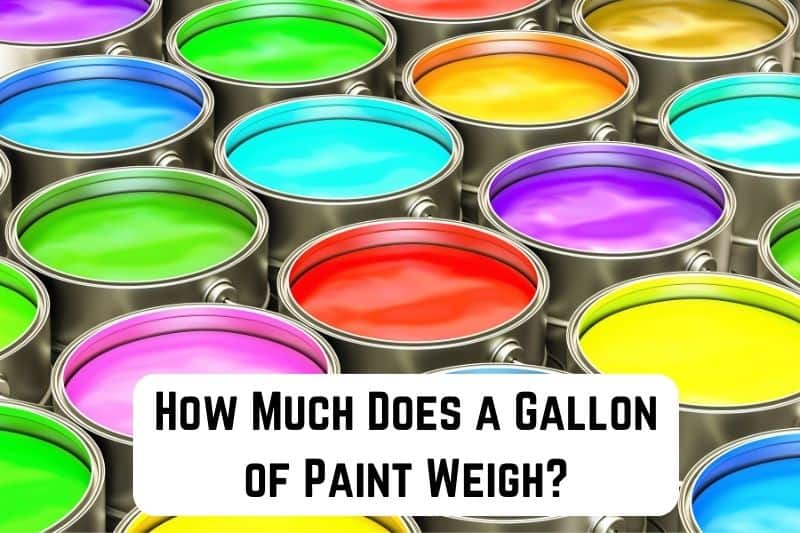When planning a painting project, it’s essential to consider not only the color and finish of the paint but also its weight. A gallon of paint can be quite heavy, and knowing the exact weight will help you estimate the overall project requirements, such as how much you’ll need to buy and how much you’ll need to carry it.
The weight of a gallon of paint can vary depending on its type, ingredients, and density. In this article, we’ll explore the factors that can affect the weight of a gallon of paint and provide some guidelines to help you estimate the weight for your specific needs.
Read: How Much Does a Book Weigh? (Detailed Guide)
The weight of a gallon of paint can vary depending on the type of paint and the ingredients used. Generally speaking, a gallon of paint weighs between 10 to 12 pounds (4.5 to 5.4 kg).
Understanding Paint Components
Let’s look at these components to understand their role in paint’s weight better.
Pigments are the particles that give paint its color and opacity. These can be either organic or inorganic materials, and their weight can vary depending on the type of pigment used. Inorganic pigments, such as titanium dioxide, are usually denser and lead to a heavier paint.
Binders are the substances that hold the pigment particles together and help the paint adhere to surfaces. Common binders include acrylic, latex, and alkyd resins. The type and quantity of binder can impact the weight of the paint, with some resins being heavier than others.
Solvents are the liquids used to thin the paint and make it easier to apply. This component can be water or a variety of organic compounds. Solvents typically evaporate as the paint dries, leaving the pigment and binder behind. However, they still contribute to the initial weight of a wet gallon of paint.
Additives are optional ingredients that can enhance certain properties of the paint, such as drying time, flow, and durability. Additives can include a range of materials, like thickeners, stabilizers, and fungicides. While they are usually present in smaller amounts, they can still affect the overall weight of the paint.

How Much Does a Gallon of Paint Weigh?
The weight of a gallon of paint can vary depending on the type of paint and the ingredients used. Generally speaking, a gallon of paint weighs between 10 to 12 pounds (4.5 to 5.4 kg).
Keep in mind that the specific weight of the paint can change based on the following factors:
- Type of paint: Different types of paint, like latex, oil-based, or acrylic, can have different weights due to their composition. Latex paint is typically heavier, weighing around 11 to 12 pounds (5 to 5.4 kg) per gallon, while oil-based paint weighs slightly less, around 10 pounds (4.5 kg) per gallon.
- Pigments and additives: The weight of a gallon of paint can also be influenced by the pigments and additives used to create the specific color or finish you desire. Heavier pigments and more additives can potentially increase the weight of the paint.
- Percentage of solids and water: The ratio of solids to water in the paint will affect its weight as well. Paints with a higher percentage of solids (pigments and binders) and less water tend to weigh more.
When estimating the amount of paint needed for your project, remember that the weight of the paint isn’t the only factor to consider. You’ll also need to consider the coverage – how many square feet a gallon of paint will cover.
Standard Weight of a Gallon of Paint
Water-based paints, or latex or acrylic paints, are the most common for home use. These paints generally weigh between 8.5 to 12 pounds per gallon due to their light solvents and small amounts of additives.
For example, a gallon of interior latex paint typically weighs around 10 pounds, while exterior latex paint might weigh closer to 12 pounds.
Oil-based paints, on the other hand, are heavier due to their thicker consistency and higher amounts of additives and solvents. A gallon of oil-based paint can weigh between 12 to 15 pounds. You’ll generally encounter oil-based paints in specialized applications, such as industrial or marine settings.
In addition to these common types of paint, specialty paints may have different weights. For example:
- Textured paint can weigh between 13 to 15 pounds per gallon, containing heavier elements like sand or other additives to create the desired texture.
- Epoxy paint typically weighs around 10 to 12 pounds per gallon. This type of paint is often used on concrete surfaces and requires a hardener to be mixed in before application.
- Fire-resistant paint can weigh up to 14 pounds per gallon, depending on the specific formulation. This paint is designed to slow fire spread, often used in commercial or industrial settings.
Keep in mind that the container itself will add some weight. Metal cans usually weigh around 0.5 to 1.5 pounds, while plastic containers are slightly lighter at 0.3 to 1 pound. It’s also worth noting that paint density can affect weight.
Impact of Paint Type on Weight
In this section, we’ll cover some common paint types and how their weight may differ.
Latex paint, often used for wall painting, is water-based and typically weighs around 10-12 pounds per gallon. Since it contains more water, it’s slightly lighter than other paint types.
On the other hand, alkyd paint, which is oil-based, usually weighs a bit more. Its weight ranges anywhere from 12-14 pounds per gallon. The higher weight is mainly due to additional solvents and chemicals in the formula.
Epoxy paint, known for its durability and use in industrial settings, is another type with a weight discrepancy. Generally, epoxy paint weighs close to 14-16 pounds per gallon. This increased weight is attributable to the resins and hardeners that make this paint sturdy and long-lasting.
To give you an idea of how these paint types compare in terms of weight, you can consider the following table:
| Paint Type | Weight per Gallon (in pounds) |
|---|---|
| Latex | 10-12 |
| Alkyd | 12-14 |
| Epoxy | 14-16 |

Factors Influencing Paint Weight
Type of paint: There are various types of paint available in the market, such as latex, acrylic, and oil-based paints. The weight of a gallon of paint will vary depending on your chosen type.
For example, a gallon of latex paint typically weighs around 11 pounds, while oil-based paint can weigh between 6.5 and 12.5 pounds.
Pigments and additives: The weight of a gallon of paint is also influenced by the pigments and additives in the formula. Heavier pigments, like titanium dioxide, will increase the overall weight of the paint. Some additives, like extenders and thickeners, can also add to the paint weight.
Solid content: The amount of solids in the paint will also affect its weight. Solids are components like pigments, binders, and additives, and they can contribute to the overall weight of the paint. Higher solid content usually results in a heavier gallon of paint.
Package material: It’s worth mentioning that the paint container can add to the overall weight of the paint. Typically, paint cans are made out of metal or plastic, and their weight may range from a few ounces to a couple of pounds.
Read: How Much Does a Gallon of Oil Weigh? (Answered)
Reasons for Weight Variation
The weight of a gallon of paint can vary due to several factors. These reasons can impact the overall density and makeup of the paint, thus affecting its weight. Let’s explore some of these factors to help you better understand the weight variations.
1. Type of paint: Different types of paints have different compositions. Latex paints usually weigh between 10-12 pounds per gallon, while oil-based paints typically range between 6-8 pounds. This difference is mainly because of the ingredients used, as oil-based paints have a higher solvent content compared to latex paints.
2. Pigment concentration: The amount of pigment in paint can also impact its weight. Heavily pigmented paints tend to be denser and heavier. For example, deeply saturated hues, such as dark blues or reds, may have more pigments, contributing to a heavier gallon of paint.
3. Additives and fillers: Paint may contain additives and fillers that can affect its weight. These materials, such as thickeners, stabilizers, or flatting agents, are added to enhance the paint’s performance. The type and quantity of these additives can impact the overall weight of the paint.
4. Water content: The water content in paint can contribute to its weight. Many paints, particularly latex paints, contain water as a major component. However, as the paint dries, the water evaporates, reducing the weight of the paint. Higher water content in your paint gallon will initially produce a heavier product.
Remember that the label on the paint can sometimes display the weight of the entire package, including the can itself, which can also weigh about 1-2 pounds. Being aware of these factors will help you estimate the weight of a gallon of paint based on its type and composition.







